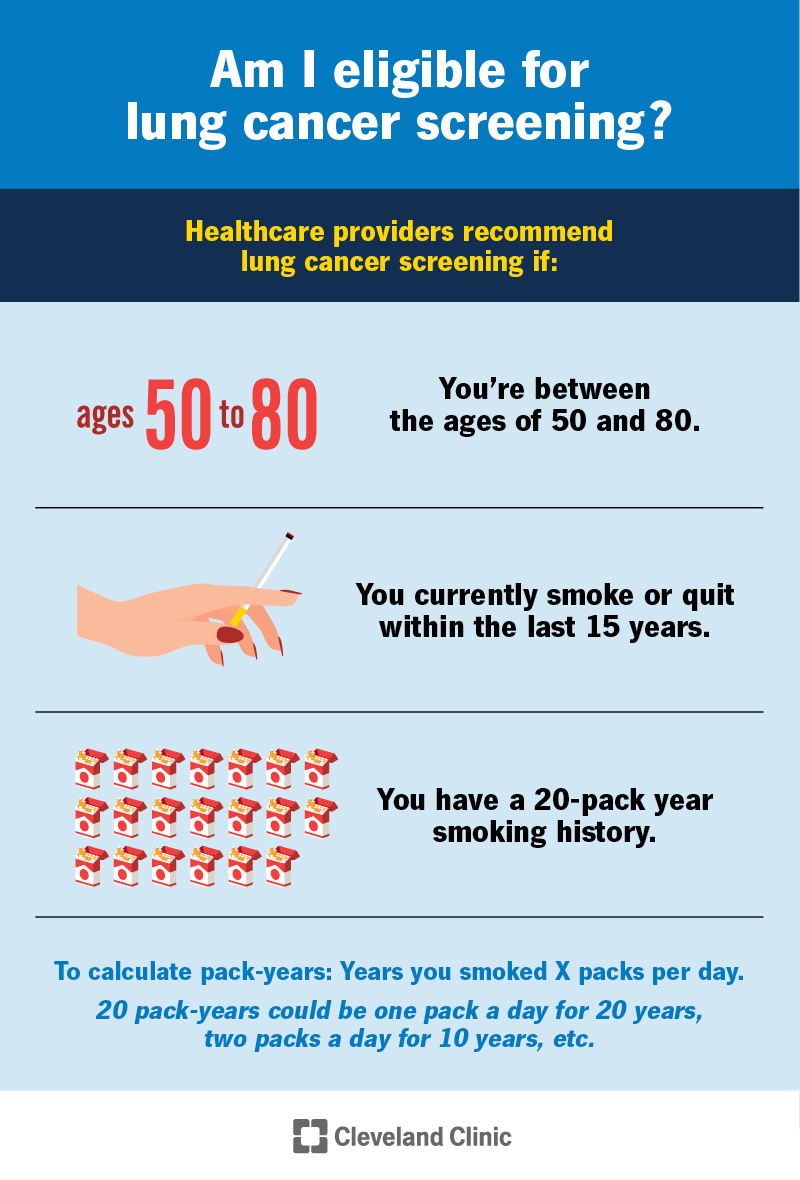Lung cancer screening is a tool healthcare providers use to detect lung cancer early, when it’s more easily treated. They take images of your lungs once a year with a low-dose CT scan. Lung cancer screening is recommended for people between the ages of 50 and 80 who smoke or who quit less than 15 years ago.
Advertisement
Cleveland Clinic is a non-profit academic medical center. Advertising on our site helps support our mission. We do not endorse non-Cleveland Clinic products or services. Policy

Lung cancer screening is a yearly low-dose CT scan (LDCT) that can show potentially cancerous tumors when they’re still small. LDCT scans take pictures of the insides of your lungs. Screening means that you have a regular test or imaging to catch a disease before it starts causing symptoms.
Advertisement
Cleveland Clinic is a non-profit academic medical center. Advertising on our site helps support our mission. We do not endorse non-Cleveland Clinic products or services. Policy
You might wonder why you’d look for cancer if you don’t have any symptoms. But lung cancer rarely causes symptoms in the early stages, when it’s easier to treat. Lung cancer is often found in later stages, when survival rates are lower.
You should start getting screened at age 50 if you currently smoke or quit within the past 15 years. While anyone can get lung cancer, people who smoke or used to smoke are at a higher risk.
Healthcare providers recommend that you get a low-dose CT scan for a lung cancer screening every year if you meet all of the following:
*To calculate your “pack-years,” multiply the number of years you’ve smoked by the number of packs (20 cigarettes) you smoke each day. For instance, a 20-pack year smoking history could mean you’ve smoked a pack a day for 20 years or that you used to smoke two packs a day for 10 years. Ask a healthcare provider if you aren’t sure how to figure out your pack-year history.
The United States Preventive Services Task Force (USPSTF), a group of healthcare experts, developed these guidelines based on the most recent lung cancer screening studies.
Advertisement
Lung cancer screening works by getting pictures of the inside of your chest. The pictures don’t diagnose cancer on their own, but they can show small masses that can then be tested for cancer.
You usually don’t need to do anything to prepare for a lung cancer screening CT scan, but ask your healthcare provider to make sure they don’t have instructions for you. You might want to wear clothing that’s easy to change out of and minimal jewelry. Let your provider or the staff at the imaging center know if you’re sick, especially with a respiratory illness. They may have you reschedule your scan to make sure it’s as accurate as possible.
During a lung cancer screening test:
There are no special instructions you have to follow after an LDCT.
Risks of lung cancer screening include:
Sometimes, scans show conditions that your provider wasn’t looking for as a part of a lung cancer screening (incidental finding). These could include conditions that need treatment, like COPD (chronic obstructive pulmonary disease) or a breast mass. But incidental findings don’t always need treatment and can lead to unnecessary tests and stress.
The advantages of lung cancer screening with low-dose CT include:
Advertisement
A radiologist and your healthcare provider will review your scans and you’ll get a report with the results. Your radiologist might use these descriptions in your lung cancer screening results:
The length of time it takes to receive lung cancer screening results can vary. If you need immediate follow-up, you’ll usually hear from your provider quickly. Otherwise, it might be anywhere from a day to several days. Ask your provider when you can expect the results.
Advertisement
Your provider will discuss the results of your lung cancer screening with you. If necessary, possible next steps could include:
Talk to your healthcare provider if you think you’re at a higher risk for lung cancer and could be eligible for screening. Don’t hesitate to ask them if you have any questions about low-dose CT or the results of your screening.
You can stop yearly screenings for lung cancer if any of these are true:
Lung cancer screening increases the likelihood that if you do develop lung cancer, you’ll be diagnosed at an early stage when it’s more treatable. Studies suggest that over 50% of people (or 1 in 2) diagnosed with lung cancer through annual screening are diagnosed at an early stage, compared to about 28% of all people diagnosed with lung cancer at an early stage.
Advertisement
There are no blood tests that screen for or diagnose lung cancer.
Lung cancer is a serious diagnosis. But annual screening can be a powerful tool for catching it early, with the most effective treatment options available. Talk to your provider about whether you’re at a higher risk for lung cancer and if you should get screened. It could save your life.
If you have lung cancer, you might feel alone and afraid. You don’t have to be. Cleveland Clinic is here to help find and treat your cancer at any stage.

Last reviewed on 08/16/2024.
Learn more about the Health Library and our editorial process.